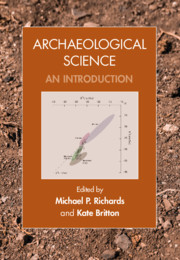Book contents
- Archaeological Science
- Archaeological Science
- Copyright page
- Contents
- Figures
- Tables
- Contributors
- Acknowledgements
- Part I Introduction
- Part II Biomolecular Archaeology
- Part III Bioarchaeology
- Part IV Environmental Archaeology
- Part V Materials Analysis
- 14 Ceramics
- 15 Glass
- 16 Metals
- 17 Lithics
- Part VI Absolute Dating Methods
- Index
- References
14 - Ceramics
from Part V - Materials Analysis
Published online by Cambridge University Press: 19 December 2019
- Archaeological Science
- Archaeological Science
- Copyright page
- Contents
- Figures
- Tables
- Contributors
- Acknowledgements
- Part I Introduction
- Part II Biomolecular Archaeology
- Part III Bioarchaeology
- Part IV Environmental Archaeology
- Part V Materials Analysis
- 14 Ceramics
- 15 Glass
- 16 Metals
- 17 Lithics
- Part VI Absolute Dating Methods
- Index
- References
Summary
Ceramics are the most abundant surviving material on almost all Neolithic and later archaeological sites. Their abundance and ubiquity is the result of several factors. Firstly, the raw materials that are used to create most ceramics are commonly available in a wide variety of areas. Most require very little in the way of specialised processing. This means that it is generally relatively inexpensive in terms of the time and energy required to gather and process the raw materials to create ceramics. Secondly, they tend to be fragile – if dropped they are easily broken. Thirdly, the broken ceramic sherds cannot easily be reused. Unlike metals, which can be sharpened or remelted, the fate of most broken ceramics is to be discarded. In contrast to the relative fragility of the complete vessel, sherds are remarkably resistant to further degradation in burial and diagenesis. This means that sherds tend to pass relatively unchanged into the hands of the archaeologist, where the reconstruction of the shape and material of the original vessel is possible. Ceramics, therefore, despite their fragility, can be extremely useful, both to the societies who have employed them, usually in great abundance, and to the scientists who study them.
- Type
- Chapter
- Information
- Archaeological ScienceAn Introduction, pp. 335 - 346Publisher: Cambridge University PressPrint publication year: 2020



